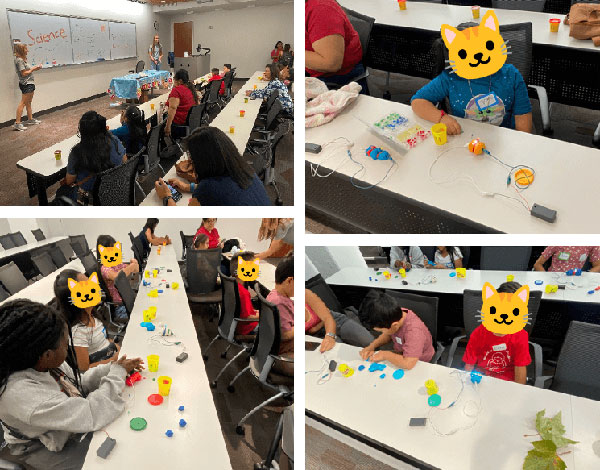Emily Carroll Electrifies Classroom Crafts
 As a scientist, it’s our job to think both creatively and analytically to advance
scientific knowledge and solve problems. Sometimes, I find myself so caught up in
the details of my research that I can forget how truly beautiful and inspiring science
can be. Science is for everyone, and everyone can do science. This is the lesson that
I am constantly reminded of when I engage with communities of all ages, as it’s never
too early (and never too late) to be inspired. This Fall, I was reminded of the joy
of scientific discovery when I had the opportunity to engage with elementary age students
during a local science day. Thinking back to my days in elementary school, some of
my fondest memories were created during field trips around our town. Visiting sculpture
gardens, art museums, local sports games, simply the opportunity to ride on the bus
with my friends was enough to cast a sense of excitement throughout the class on the
day of a field trip. But no trip was as special as visiting the university. Everything
was bigger and better at the college campus- the towering campus buildings, college
students walking between classes, colorful flower beds, dining halls!!! Such a bustling
atmosphere of learning and problem solving.
As a scientist, it’s our job to think both creatively and analytically to advance
scientific knowledge and solve problems. Sometimes, I find myself so caught up in
the details of my research that I can forget how truly beautiful and inspiring science
can be. Science is for everyone, and everyone can do science. This is the lesson that
I am constantly reminded of when I engage with communities of all ages, as it’s never
too early (and never too late) to be inspired. This Fall, I was reminded of the joy
of scientific discovery when I had the opportunity to engage with elementary age students
during a local science day. Thinking back to my days in elementary school, some of
my fondest memories were created during field trips around our town. Visiting sculpture
gardens, art museums, local sports games, simply the opportunity to ride on the bus
with my friends was enough to cast a sense of excitement throughout the class on the
day of a field trip. But no trip was as special as visiting the university. Everything
was bigger and better at the college campus- the towering campus buildings, college
students walking between classes, colorful flower beds, dining halls!!! Such a bustling
atmosphere of learning and problem solving.
Now, after enjoying my 20th year in school, I still feel the same excitement walking around campus. The same excitement I could feel the students buzzing with after they ran off the bus that brought them from the west side of Salt Lake City, from the elementary school all the way to the giant campus of the University of Utah. This fall day was Science Day. Hosted at the Marriot Library at the University of Utah, elementary age students visited a variety of science themed rooms to participate in hands-on activities. My area of research is electrochemistry, so I ran the electrochemistry activity where the students learned about electricity, electron flow, circuits, and conductive mediums through a hands-on activity we call “squishy circuits.” In this activity, we use a battery, conductive and insulating doughs (PlayDough and modeling clay), and LED lights to imagine and create unique circuits. Squishy circuits are a fun, hands-on activity to teach electricity and electron flow while also giving the kids an opportunity to be creative designing and sculpting PlayDough objects. We started with a brief demo on how to set up a basic circuit and demonstrated how to illuminate an LED light. The basic principle is that electrons will flow from a battery, through a conductive medium (such as a wire), to a lightbulb, and circle back to the other end of the battery through another wire. When the battery is switched “on”, the electricity lights up the light bulb. Wire isn’t the only conductive medium capable of shuttling electrons in a circuit, the students saw a demonstration that a LED light would illuminate through the squishy material PlayDough, too! The electric flow though the dough is supported by electrolyte, basically, the dough is salty. No sooner than that fact was mentioned were the tubes of PlayDough out of the container and thoroughly inspected (tasted) by all the eager scientists. Smart- it’s always good to double check.

The kids designed and sculpted their own circuits, turning blobs of PlayDough into marvelous sculptures of dogs, trees, caterpillars, pumpkins, hamburgers, and nondescript brown….piles…After learning how to light one LED light in a basic circuit, the young scientists eventually moved on to more complicated designs. But if we know one thing about the scientific process, it’s that we don’t always succeed the first time. Although seemingly simple at first glance, these circuitry parts had a few nuances. For example, there was a positive and negative end of the battery as well as the LED light wires (one short and one long wire), such that the alligator clamps connecting the battery to the dough had to align with the direction of the LED in order to complete the circuit. Despite these advanced concepts being introduced to elementary age students, it was incredible to witness their ability to identify patterns and problem solve on their own. They learned how to troubleshoot their circuit if the light did not light up and taught their friends and chaperones the concepts behind their circuit. Many of the parent chaperones participated in the activity, too, primarily speaking Spanish with their children. Not only were the students able to watch me demonstrate a new topic and recreate it themselves, but they were also able to turn around and teach what they had just learned to their parent in a different language. I was truly impressed.
In my reflection of this activity, I was reminded that kids are very preceptive and many of them picked up the concept of how electricity flows very quickly. Every single student was engaged with the activity not just in passive participation, but actively asking questions and being inquisitive about the science topics discussed. Even through the chaos of giving 9-year-olds colorful, messy pieces of dough, the joy of learning was inspiring. I think we might have a few future scientists!!

About the Blog
Discussion channel for insightful chat about our events, news, and activities.
Categories
Featured Posts
Tag Cloud
- UoG (2)
- Guam (2)
- ethnobotany (1)
- environmental policy (1)
- student immersion (1)
- engineering (1)
- Virgin Islands (1)
- USVI (2)
- lionfish (1)
- children's home (1)
- conservation (1)
- marine ecology (1)
- youth (1)
- sustainability (2)
- Utah (1)
- Arizona (1)
- Nevada (1)
- southwest (1)
- virtual (1)
- project management (1)
- training (1)
- naturalist (1)
- forest (1)
- ecosystem (1)
- Puerto Rico (1)
- Spanish (1)
- library (1)
- Huntington's (1)
- medical science (1)
- Emmanuel Ngwoke (1)
